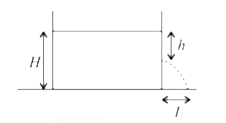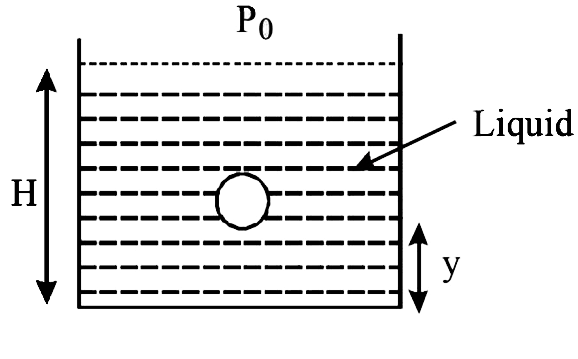Suppose a liquid in a container is heated at the top rather than at the bottom. What is the main process by which the rest of the liquid becomes hot?
The correct Answer is:C, D
To solve the question about how a liquid in a container becomes hot when heated from the top rather than the bottom, we can break down the explanation into clear steps:
1. Understanding Heating from the Bottom:
- When a liquid is heated from the bottom, the heat source warms the liquid at the bottom first. As the temperature increases, the density of the liquid decreases.
- The warmer, less dense liquid at the bottom rises, while the cooler, denser liquid at the top sinks. This creates a circulation pattern in the liquid known as convection.
2. Understanding Heating from the Top:
- If the liquid is heated from the top, the heat is applied to the upper layer of the liquid. As this layer heats up, its density decreases.
- However, since the lighter, warmer liquid is already at the top, there is no denser liquid below it to push upward. Therefore, the typical convection currents that would distribute heat throughout the liquid do not occur.
3. Heat Transfer Mechanism:
- In the absence of convection (which is the case when heating from the top), the only remaining method for heat transfer in the liquid is conduction.
- Conduction is the process where heat is transferred through direct contact between molecules. The heated upper layer of the liquid will transfer heat to the layers below it through conduction.
4. Conclusion:
- Therefore, when a liquid is heated from the top, the main process by which the rest of the liquid becomes hot is conduction.
Final Answer:
The main process by which the rest of the liquid becomes hot when heated from the top is conduction.
---
- When a liquid is heated from the bottom, the heat source warms the liquid at the bottom first. As the temperature increases, the density of the liquid decreases.
- The warmer, less dense liquid at the bottom rises, while the cooler, denser liquid at the top sinks. This creates a circulation pattern in the liquid known as convection.
- If the liquid is heated from the top, the heat is applied to the upper layer of the liquid. As this layer heats up, its density decreases.
- However, since the lighter, warmer liquid is already at the top, there is no denser liquid below it to push upward. Therefore, the typical convection currents that would distribute heat throughout the liquid do not occur.
- In the absence of convection (which is the case when heating from the top), the only remaining method for heat transfer in the liquid is conduction.
- Conduction is the process where heat is transferred through direct contact between molecules. The heated upper layer of the liquid will transfer heat to the layers below it through conduction.
- Therefore, when a liquid is heated from the top, the main process by which the rest of the liquid becomes hot is conduction.
The main process by which the rest of the liquid becomes hot when heated from the top is conduction.
Topper's Solved these Questions
- BOOK - DC PANDEY ENGLISHCHAPTER - CALORIMETRY & HEAT TRANSFEREXERCISE - Assertion And Reason10videos
CALORIMETRY & HEAT TRANSFER
- BOOK - DC PANDEY ENGLISHCHAPTER - CALORIMETRY & HEAT TRANSFEREXERCISE - Level 1 Objective11videos
CALORIMETRY & HEAT TRANSFER
- BOOK - DC PANDEY ENGLISHCHAPTER - CALORIMETRY & HEAT TRANSFEREXERCISE - Exercise 22.17videos
CALORIMETRY & HEAT TRANSFER
- BOOK - DC PANDEY ENGLISHCHAPTER - BASIC MATHEMATICSEXERCISE - Exercise13videos
BASIC MATHEMATICS
- BOOK - DC PANDEY ENGLISHCHAPTER - CALORIMETRY AND HEAT TRANSFEREXERCISE - Medical entrance s gallery38videos
CALORIMETRY AND HEAT TRANSFER
Similar Questions
Name the process by which water from plants is lost in liquid form
View SolutionThe process by which a solid changes into a liquids is called
View SolutionThe pressure at the bottom of a liquid container is determined by the
View SolutionHeat is tranmitted in liquids by the process of :
View SolutionA liquid is filled in a container to a height H. A small hole is opened in the side of the container a height h below the surface of the liquid. The distance L from the bottom of the container of the point where the stream of liquid leaving the container meets the ground is :
 View Solution
View SolutionA gas in a closed container will exert much higher pressure due to gravity at the bottom than at the top.
View SolutionGas in a closed container will exert much higher pressure due to gravity at the bottom than at the top.
View SolutionWhich process refers to the change of state from liquid to solid?
View SolutionA small spherical monoatomic ideal gas bubble (γ=5/3) is trapped inside a liquid of density ρ (see figure). Assume that the bubble does not exchange any heat with the liquid. The bubble contains n moles of gas. The temperature of the gas when the bubble is at the bottom is T0, the height of the liquid is H and the atmospheric pressure P0 (Neglect surface tension).

When the gas bubble is at a height y from the bottom, its temperature is-View SolutionA small spherical monoatomic ideal gas bubble (γ=53) is trapped inside a liquid of density ρl (see figure) . Assume that the bubble does not exchange any heat with the liquid. The bubble contains n moles of gas. The temperature of the gas when the bubble is at the bottom is T0, the height of the liquid is H and the atmospheric pressure is P0 (Neglect surface tension).
_E01_434_Q01.png)
When the gas bubble is at a height y from the bottom , its temperature is :-View Solution

